The Benefits of Swimming for Health, Fun, or Relaxation! Dive in!
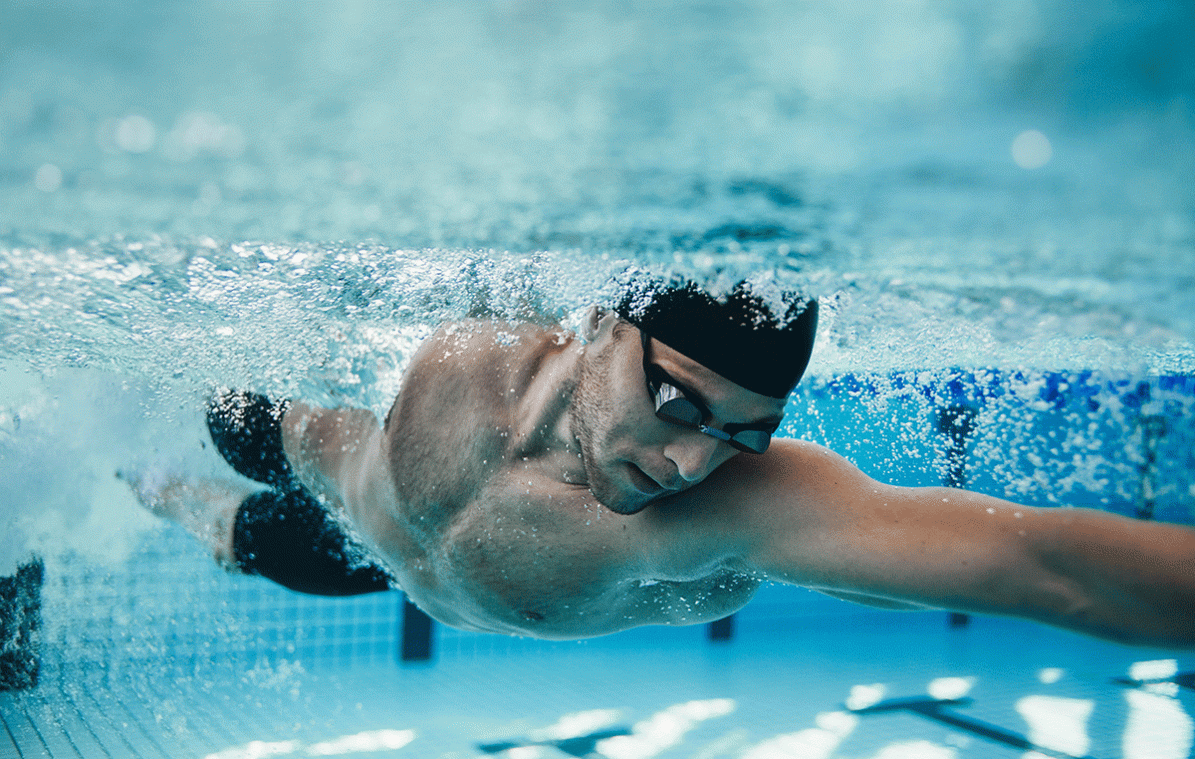 ©Jacob Ammentorp Lund
©Jacob Ammentorp Lund
Swimming is a great way to improve your fitness level and general health. Here, we’ll tell you all about the benefits of swimming including what you need to know to get started.
What are the benefits of swimming?
Swimming can have many health benefits provided you’re doing it properly and tailoring your workouts to suit your needs.
Your body will benefit from movements made in the pool even if you’re just starting out, because swimming is a low impact sport which means it exercises the cardiovascular system and strengthens the muscles without harming the musculoskeletal system.

Swimming is a whole body workout because it engages almost all of your muscles. Every stroke works out your back muscles, though you can also strengthen specific muscles by incorporating a series of targeted movements. Swimming is also a great way to release the common muscle tension many of us develop from sitting at a desk all day.
It’s an effective form of training that lowers your heart rate.
Your heart rate is lower when you’re physically active in the water than when you’re exercising on land. That’s not to say that swimming is less effective than running or biking, though. The decrease is caused by something called the immersion reflex, which stimulates the parasympathetic nervous system responsible for your body’s recovery mechanisms. It regulates our bodies unconscious management of the pulse and the centralization of blood circulation, among other things. In other words, your body is fully focused on supplying oxygen to your vital organs when immersed in water.
Water pressure and the horizontal position in which you swim also promotes blood flow and increases the heart’s stroke volume—the amount of blood pumped out by the left ventricle of the heart. This causes the heart to provide enough blood to the body with fewer beats than normal.
How many calories do you burn while swimming?
The number of calories you burn during a swim session depends on your overall fitness level and physical predisposition. The type of swimming you do and the intensity of the workout session also play a big part. One thing’s for sure: Even just casually soaking while chatting can burn more calories than simply sitting in a coffee shop. As with any workout, though, you’ll need to make a certain amount of effort to burn the amount of calories you want.
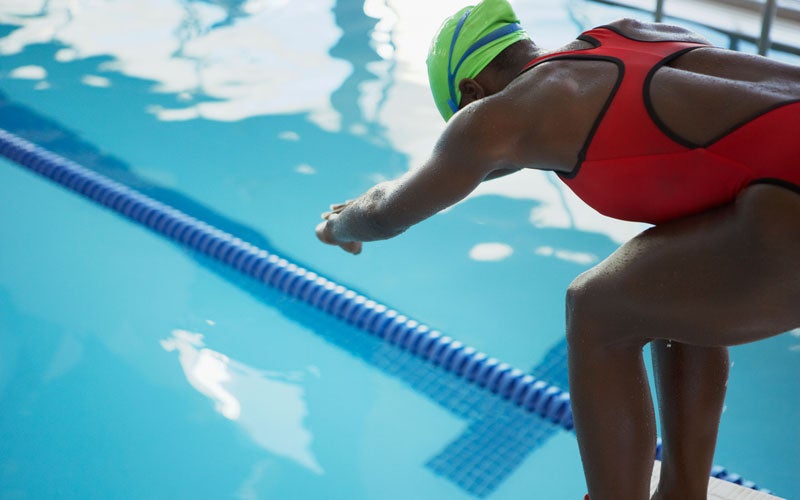
Our tip: If you’re trying to lose weight and aren’t sure how many calories you need to burn to reach your goals, use our Body Check to find out in minutes!
How many calories does a swim session burn?
The following data shows the average amount of calories burnt during a single swimming session. These are the general values that amateur athletes and swimmers use to light their way. If you want to find out exactly how many calories you burn while swimming, use an activity monitoring device during your workout.
Caloric expenditure of swimming
- Breaststroke caloric expenditure: 400 to 700 kcal/hour
- Front crawl caloric expenditure: 500 to 800 kcal/hour
- Backstroke caloric expenditure: 200 to 500 kcal/hour
3 good reasons to consider swimming if you’re trying to lose weight
If you’re trying to lose weight, regular swimming sessions can be a great way to reach your goal. If your joints are starting to hurt, swap your typical running or cycling session for a dip in the pool and a few laps. Both strength training and cardio can be done in the water!
1. Body temperature vs. water temperature
The temperature of most public swimming pools is usually between 26° and 29°, which is 10 to 13° lower than the average body temperature. This difference in temperature activates fat burning mechanisms and stimulates thermogenesis, which is the production of heat by your body. As your body tries to maintain its temperature, it ends up burning even more fat and calories, even if you just got in the pool!
2. Swimming is good for your joints
High impact workouts like running can take a high toll on your joints and musculoskeletal system, and the heavier you are, the larger that impact is. On the other hand, swimming has little to no impact on these systems because your body floats in water and that takes the load off of your bones and joints, no matter how much you move in the pool.
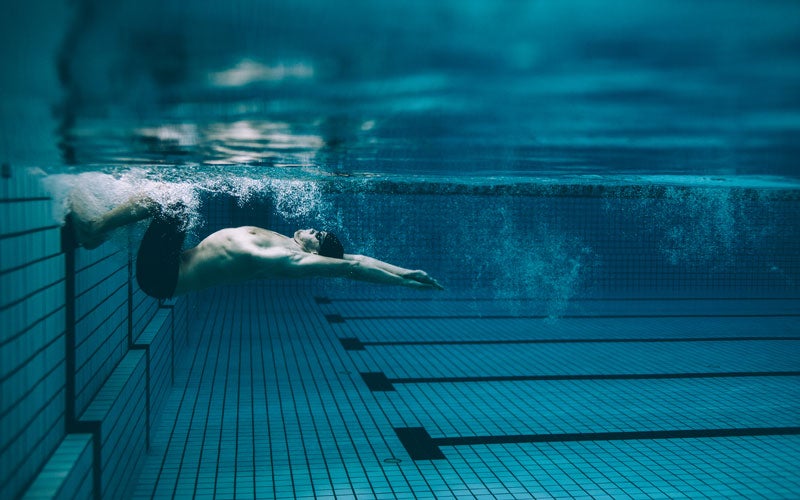
Our tip: If you’re just starting out, take swimming lessons or give yourself a few hours of practice to perfect your technique. Not only will this eventually help you burn more calories, but will also reduce your risk of injury.
3. Swimming can be a great addition to a varied and balanced training plan.
Swimming engages the entire body and strengthens all the major muscle groups through water resistance. Swimming regularly will build muscle mass and increase your basal metabolic rate (BMR) over time.
The higher your BMR is the more calories you burn at a resting state, which means that you can eat more calories than before without gaining weight.
If swimming is your main cardio activity, it’s important to remember that it can be extremely strenuous for the upper body. Swimming the night before an upper body workout may prove to be too much of a strain.
Our tip: Consuming fewer calories is essential in order to lose weight. Our shape recipes make it easy to fill up while also cutting back because they’re both delicious and good for you.
Is swimming good for building muscle?
We’re all familiar with the characteristic swimmer’s body, but it doesn’t just appear out of nowhere. Performance-oriented swimming workouts engage the muscles so intensely that a noticeable difference presents itself in no time, especially in the shoulders and back.
Swimming stimulates all the major muscle groups as well as intermuscular coordination. The broad back swimmers are known for having is thanks to breaststrokes and front crawls, which strengthen the arms and back as well as the trapezius muscles. It’s not just these muscles that get stronger, though. The rest of the movements contribute to the fitness level of your legs, core, and beyond. Beginning to swim will gradually help you develop muscle mass around your whole body.
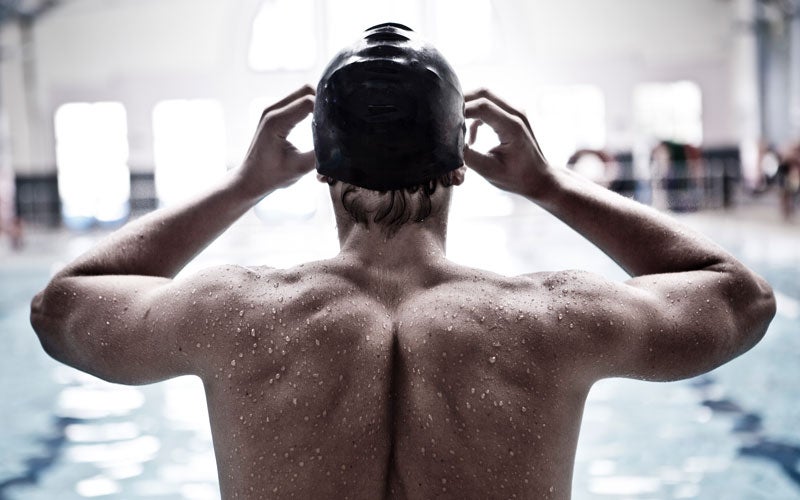
Swimming at a moderate speed is also a great way to improve your endurance abilities. Working out in this way won’t cause your muscles to grow in volume, but it will improve their definition and ability to perform. In order to increase the volume of your muscles, anaerobic workouts are necessary.
Anaerobic exercise is a form of physical activity in which your body doesn’t use oxygen to produce the energy it needs to perform movements (as opposed to aerobic exercise which does use oxygen). Because it’s a relatively strenuous practice, it can and should only last for a short period of time.
HIIT (high intensity interval training) is one way to incorporate this type of training into your swimming regimen. For example, try doing 5 intervals of 50m of fast swimming interspersed with 25m of relaxed swimming.
Each individual has their own anaerobic threshold. In order to find out what yours is, it may be worthwhile to undergo a lactate test by a physical therapist or sports doctor. He or she will determine your aerobic-anaerobic threshold and tell you the ideal heart rate for both your anaerobic and aerobic exercise.
If you don’t feel the need for such precise numbers, you can use the following method to figure out what’s best for you: During intervals, swim at a speed that allows you to say a few words but not to carry on a conversation.
How swimming can help you develop muscles
Swimming as exercise may not improve your endurance right away, but it can still have many health benefits for gym enthusiasts.
- As your muscle mass increases so does your lactic threshold, which means you’ll tire less quickly and be able to do more repetitions.
- It causes something known as the capillary effect, which efficiently supplies your muscles with nutrients and energy and improves your performance and ability to recover.
- The combination of these two effects can help you recover faster.
Our tip: A balanced diet is imperative to developing muscular mass. Plenty of protein and healthy snacks will guarantee you have everything you need.
discover our muscle building range
Which muscles does swimming work?
Though your entire body is engaged while swimming, each different stroke will train a different muscle. As with any exercise, technique is important. The more effectively you move, the more efficiently your muscles will enjoy the full benefits of swimming.
Breaststroke
Doing the breaststroke engages your back, dorsal, and abdominal muscles. Your abs stabilize your body in the water, while you engage your glutes, as well as the front and back of your thighs, to move your legs to kick.
Backstroke
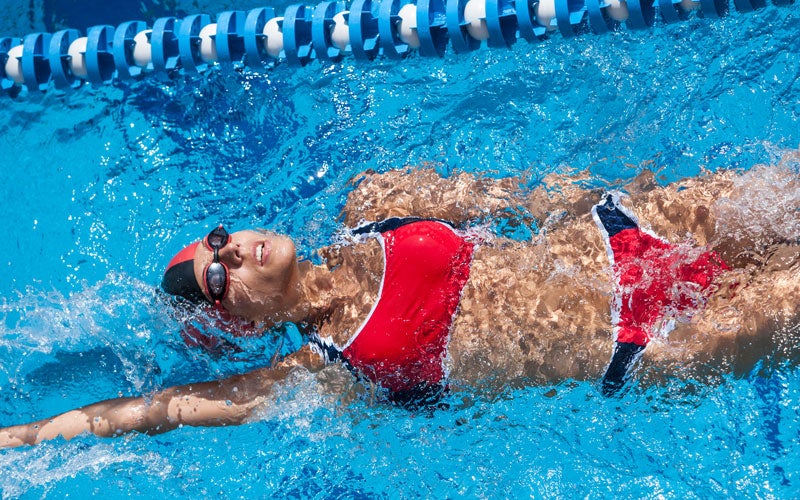
Backstroke engages all of the muscles in your glutes (large, medium, and small gluteal muscle). By keeping your body horizontal and keeping your butt from sinking while you swim, you also end up strengthening your core muscles. And because most of the movement is in the upper body, your large dorsal muscle is also engaged.
Swimming on your back also improves the mobility of the shoulder girdle. Resting your head and neck gently on top of the water also allows you to release some muscle tension from your long work days.
Front crawl
The front crawl (freestyle) engages a lot of muscle groups, including the chest, arms, shoulders, upper back, straight abdominal muscle, obliques, lower back, glutes, hips and legs. The large dorsal muscles and trapezius muscles gain the most benefits.
This stroke is more than just windmilling your arms as fast as you can, though. Try to coast as much as possible between strokes; the less your arms have to cycle around, the more powerful and efficient your technique is.
If you want a full-body workout with targeted exercises, try out our free strength training sessions – fun, sweat, and success guaranteed.
Discover our strength training workouts
What are the health benefits of swimming?
Swimming is an effective cardiovascular workout that doesn’t harm the musculoskeletal system and protects the joints. In order to get the most from it, you need to choose a stroke that suits your needs and master the technique.
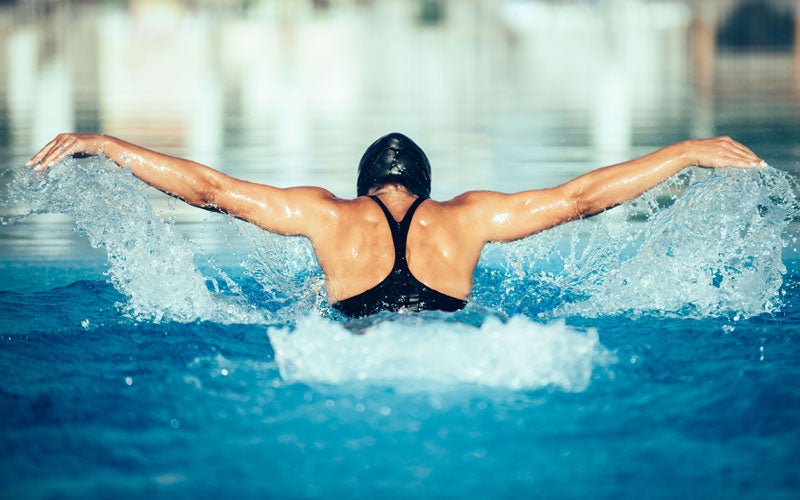
If you’ve injured your shoulder, for example, the crawl is not a good idea unless you’ve mastered the technique. Analyze your needs to determine what swim goals are best for your health.
Is swimming good for your health? Overview of the different strokes
Every type of swimming can be good for you if you’ve mastered the technique. When in doubt, backstroke is a pretty safe bet. However, depending on the level of intensity, frequency of sessions, and degree of mastery, the following strokes can bring a few problems:
Breaststroke
- Tensions in the cervical spine
- Back problems due to hyperlordosis (hunched back)
- Knee problems due to incorrect leg movements or previous injury
Front crawl
- Tension in the neck due to breathing on one side
- Increased muscle imbalances
- Shoulder injuries due to overextension
How often should you swim?
To fully reap the health benefits of swimming, try to practice at least 30 minutes of any endurance sport 3 times a week. It doesn’t have to be swimming every time. For example, consider doing two swims and one jog, or vice versa.
Ideally, you should aim to swim for about 30-40 minutes without a break. Of course, you don’t have to do 30 minutes of swimming right away. Start with a 20 minute session, and increase by 2 minutes each workout.
It’s always better to start a new physical activity at a speed that you know you can maintain over time. Going too fast in the beginning will burn you out before the good part of the workout has even started. Of course, if your session was too easy, increase your speed next time. An indicator of a good swim is being slightly out of breath when you get out of the water.
Depending on your goal, try to include 2 to 4 swims in your weekly routine to improve your progress.
Whether you’re trying to improve your general health, mental health, or gain muscle, even swimmers need time to recover. Use our tips to ensure you effectively recover after a workout.
What you need to know about swimming certifications
In the UK, there are several types of certificates and diplomas you can earn to establish your swimming abilities. While they’re mostly for children, there are also beghttps://www.swimming.org/library/documents/2905/downloadinning swim courses for adults. If you want to take it to the next level, you can even test for the Safety Training Award (STA) that’s necessary to become a swim teacher, and it’s recognized internationally so you can take your skill with you wherever you go. Don’t worry if you don’t have much prior experience in the pool, though, because you don’t need to have any previous qualifications to take a course.
8 Ways to Improve Your Swimming Technique
If you want to learn how to swim correctly, a few swim lessons can be a big help – there are even swim lessons for adults! Just because you can keep yourself afloat doesn’t mean that you’re a pro in the pool.
The better your technique, the more strokes you’ll save and the more fast and efficient your stroke will be. It’s not only about looking good, though: good technique will also minimize your risk of injury.

1. Find a trainer
Teaching yourself how to swim properly is difficult. You can’t see what mistakes you’re making and have no way of evaluating your current level or potential. Working on technique alone can also be very frustrating and boring, but with a coach by your side correcting and motivating you, you’ll make more progress and have more fun.
Our tip: To maintain your passion for swimming, set aside 1 or 2 sessions for focusing on technique with a few fun swims on the side.
2. Watch yourself
Watching yourself is the best way to see what you’re doing wrong. Ask your trainer or an exercise buddy to film you while you swim. Then, watch the video in normal and slow motion and compare them to professional swimmers to find improvement points.
3. Learn how to breathe properly
Though breathing seems basic, there is a right and a wrong way to do it when you’re working out. Breathing correctly in the water is especially crucial because it improves energy levels, speed, efficiency, and concentration. It also reduces the risk of neck and back problems and guarantees you end up swallowing less water at the same time. In general, try to avoid swallowing chlorinated water whenever possible.
4. Move gently instead of aggressively
Spend as long as you can riding the momentum of each stroke. This will help you find the perfect balance between effort and efficiency. Your goal should be to take as few strokes as possible every lap, which requires clean and powerful technique.
5. Isolate each move to practice
Swimming requires coordination and practicing each movement separately is the best way to perfect them altogether. For example, practice the front crawl kick by holding a board in your hands so your upper body can rest while you exercise your lower body. Once you’ve mastered each move, try to combine them.
6. Swim as slowly as you can
Take time to concentrate on the movement of your body, the muscles, and your gliding. It’s better to swim slowly with perfect technique than quickly with bad technique. If you focus on executing the movement exactly how you want, your body will gradually get used to it until you can swim as fast as you want.
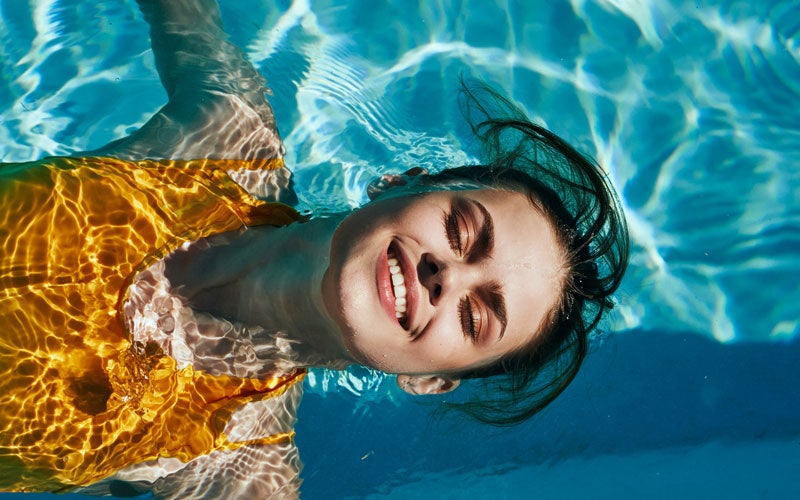
7. Focus on one stroke
Learn the breaststroke, then the backstroke, then the front crawl, and when everything seems easy, you can finally try the hardest option of all – the butterfly. Getting to this point isn’t a walk in the park (or should we say swim in the pool?). Coordinating your movements in the water is very difficult. In the beginning, train at a moderate pace and give your body and mind plenty of time to learn each individual move until you can comfortably do it all together.
8. Follow a training program
Swimming when you feel like it is fun but not the most effective way to increase your fitness level. Following a training program is the best way to ensure you meet your goal, whether that be to build muscle mass or lose weight. And you’ll need to adapt your plan to suit your starting fitness level and set yourself on the path to success.
Are you already following a swimming training plan? It’s important to check in with yourself and your abilities every six weeks to adjust your plan accordingly. What was difficult in the beginning may be a piece of cake now!
Swimmer’s equipment
Truth be told, the only thing you really need to start swimming is a comfortable swimsuit that doesn’t slip around when you’re hard at work. And a pool to swim in, clearly.
Goggles are also a good idea. They protect your eyes from chlorinated water and allow you to see what’s going on around you without having to look up. Even if you only want to do a few laps, they’ll reduce potential neck tension from having to look above the water every few strokes.
Many swimmers use nose clips or earplugs that are specially designed for swimming to prevent water from getting into their noses and ears. It’s not mandatory, but it’s a great way to minimize distractions.
Swimming: Our conclusion
- Swimming benefits the whole body, is good for health, and can improve fitness levels.
- Swimming as a workout can help you lose weight, build muscle, and improve endurance.
- Swimming is a low impact workout that has minimal impact on the musculoskeletal system.
- Practicing swimming in a healthy way requires a mastery of the different techniques involved.
Sources for this article
We at foodspring use only high-quality sources, including peer-reviewed studies, to support the facts within our articles. Read our editorial policy to learn more about how we fact-check and keep our content accurate, reliable, and trustworthy.
- Such U, Meyer T: Die maximale Herzfrequenz. In: Deutsche Zeitschrift für Sportmedizin. Jahrgang 61, Nr. 12 (2010). S. 310 – 311.
- Adult Learn to Swim Awards

































